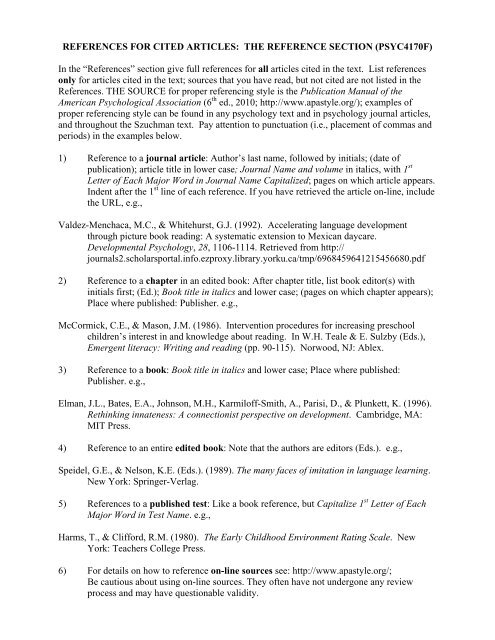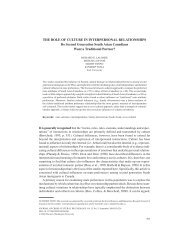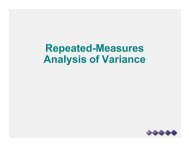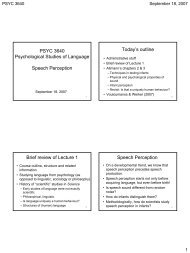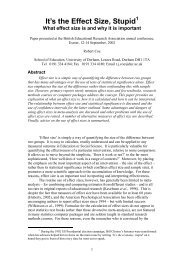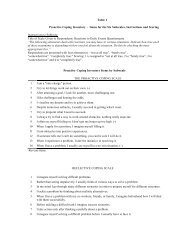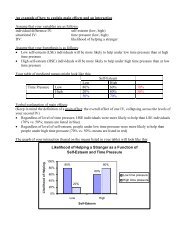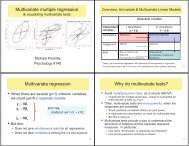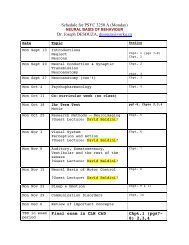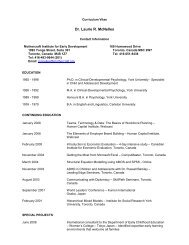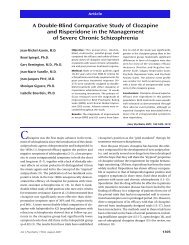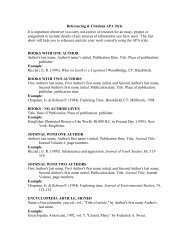REFERENCES FOR CITED ARTICLES: THE REFERENCE ...
REFERENCES FOR CITED ARTICLES: THE REFERENCE ...
REFERENCES FOR CITED ARTICLES: THE REFERENCE ...
Create successful ePaper yourself
Turn your PDF publications into a flip-book with our unique Google optimized e-Paper software.
<strong><strong>REFERENCE</strong>S</strong> <strong>FOR</strong> <strong>CITED</strong> <strong>ARTICLES</strong>: <strong>THE</strong> <strong>REFERENCE</strong> SECTION (PSYC4170F)<br />
In the “References” section give full references for all articles cited in the text. List references<br />
only for articles cited in the text; sources that you have read, but not cited are not listed in the<br />
References. <strong>THE</strong> SOURCE for proper referencing style is the Publication Manual of the<br />
American Psychological Association (6 th ed., 2010; http://www.apastyle.org/); examples of<br />
proper referencing style can be found in any psychology text and in psychology journal articles,<br />
and throughout the Szuchman text. Pay attention to punctuation (i.e., placement of commas and<br />
periods) in the examples below.<br />
1) Reference to a journal article: Author’s last name, followed by initials; (date of<br />
publication); article title in lower case; Journal Name and volume in italics, with 1 st<br />
Letter of Each Major Word in Journal Name Capitalized; pages on which article appears.<br />
Indent after the 1 st line of each reference. If you have retrieved the article on-line, include<br />
the URL, e.g.,<br />
Valdez-Menchaca, M.C., & Whitehurst, G.J. (1992). Accelerating language development<br />
through picture book reading: A systematic extension to Mexican daycare.<br />
Developmental Psychology, 28, 1106-1114. Retrieved from http://<br />
journals2.scholarsportal.info.ezproxy.library.yorku.ca/tmp/6968459641215456680.pdf<br />
2) Reference to a chapter in an edited book: After chapter title, list book editor(s) with<br />
initials first; (Ed.); Book title in italics and lower case; (pages on which chapter appears);<br />
Place where published: Publisher. e.g.,<br />
McCormick, C.E., & Mason, J.M. (1986). Intervention procedures for increasing preschool<br />
children’s interest in and knowledge about reading. In W.H. Teale & E. Sulzby (Eds.),<br />
Emergent literacy: Writing and reading (pp. 90-115). Norwood, NJ: Ablex.<br />
3) Reference to a book: Book title in italics and lower case; Place where published:<br />
Publisher. e.g.,<br />
Elman, J.L., Bates, E.A., Johnson, M.H., Karmiloff-Smith, A., Parisi, D., & Plunkett, K. (1996).<br />
Rethinking innateness: A connectionist perspective on development. Cambridge, MA:<br />
MIT Press.<br />
4) Reference to an entire edited book: Note that the authors are editors (Eds.). e.g.,<br />
Speidel, G.E., & Nelson, K.E. (Eds.). (1989). The many faces of imitation in language learning.<br />
New York: Springer-Verlag.<br />
5) References to a published test: Like a book reference, but Capitalize 1 st Letter of Each<br />
Major Word in Test Name. e.g.,<br />
Harms, T., & Clifford, R.M. (1980). The Early Childhood Environment Rating Scale. New<br />
York: Teachers College Press.<br />
6) For details on how to reference on-line sources see: http://www.apastyle.org/;<br />
Be cautious about using on-line sources. They often have not undergone any review<br />
process and may have questionable validity.
CITATIONS OF <strong>THE</strong> RESEARCH LITERATURE—APA STYLE<br />
When references are made to the research literature or when claims are made based on the<br />
literature or on someone else’s ideas, the appropriate citations must be made. There are two<br />
ways to do this:<br />
1) Make a statement, followed by the appropriate citation(s) in parentheses, e.g.,<br />
High rates of illiteracy and other forms of reading problems are found among children who are<br />
raised in poverty (Alexander & Entwisle, 1988; Valdez-Menchaca & Whitehurst, 1992).<br />
2) Include name(s) of the relevant author(s) in the sentence, with the date(s) of publication<br />
in parentheses, e.g.,<br />
McCormick and Mason (1986) found large social class differences in availability and use of<br />
printed materials in the home.<br />
Note that if there are two authors, their names are spelled out each time you cite them. If there<br />
are three or more authors, their all names are spelled out the first time you cite them; in<br />
subsequent citations spell out only the first author’s name, followed by “et al.”, e.g.,<br />
1st citation: (White, Schliecker, & Jacobs, 1989)<br />
Subsequent citations of this paper: (White et al., 1989)<br />
If you make a direct quote you must indicate this through use of quotation marks, and you also<br />
must indicate the page from which the quote was taken, e.g.,<br />
Valdez-Menchaca and Whitehurst (1992) proposed that “significant social class variance in oral<br />
language skills may be tied to differences in shared book-reading activities in the home” (p.<br />
1107).<br />
OR<br />
“Significant social class variance in oral language skills may be tied to differences in shared<br />
book-reading activities in the home” (Valdez-Menchaca & Whitehurst, 1992, p. 1107).<br />
Avoid over-use of quotations. It is better to paraphrase, i.e., summarize in your own words.<br />
When you paraphrase what someone else has written, you still must cite the source, although<br />
you do not use quotation marks, e.g.,<br />
Oral language skills vary across social classes; this may be related to differences in shared<br />
book-reading at home (Valdez-Menchaca & Whitehurst, 1992).<br />
Always try to obtain the primary source. If you must use a secondary source, use “as cited in”<br />
in the citation. In the References section, list the reference for the secondary source only (e.g.,<br />
Wigfield & Guthrie, in the example below).<br />
Wentzel found that achievement goals differed for high and low achievers (as cited in Wigfield &<br />
Guthrie, 1997).


